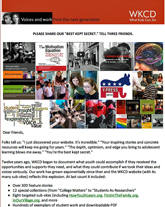OTHER WKCD WEBSITES SPECIAL COLLECTIONS Students as Allies in School POPULAR WKCD PUBLICATIONS (PDFS] A Guide to Creating Teen- Cultural Conversations through Creative Writing Documenting Immigration Stories First Ask, Then Listen: How Your Students Can Help You Teach Them Better Making Writing Essential to Profiles of Politically Active Youth Queer Youth Advice for Educators The Schools We Need: Creating Small High Schools That Work for Us | Core Elements of Teaching Practice in Student-Centered Learning by BARBARA CERVONE and KATHLEEN CUSHMAN | NOVEMBER 3, 2014
Photo by Andrew Weller What does teaching look like when it truly centers on the student’s learning needs? What practices, structures, and tools do do schools that embrace student-centered learning turn to every day to coach the intellectual, social, and emotional development of their students? Four years ago, the Nellie Mae Education Foundation and Jobs for the Future began an ambitious undertaking to move students to the center of teaching and learning in America's high schools. Eversince, "Students at the Center" has gained steam and strengthened the power of other reform efforts, from the Common Core to social-emotional learning.
As part of this effort, WKCD documented every day practice in six American high schools that prize student-centered learning.We interviewed teachers, students, and administrators and observed them at work—in classrooms, teams, exhibitions, and the community. We gathered and produced over 200 short video clips of students talking about powerful learning. From our research, a collection of core elements came to the fore. We named the elements from the vantage point of practitioners who enact them daily—who may be unaware of their research base but are acute observers of their visible impact. Here is their list:
In the chart below, we break down the elements into their most important parts. These core elements, we hasten to add, do not exist as discrete functions but in a dynamic relationship, affecting and contributing to one another. A focus on any one element (social and emotional learning, for example) inevitably leads to others (like assessment and support) as a school sees students’ development through a more holistic lens. Such correspondences remind us that student-centered teaching does not come about as schools cherry-pick its elements one by one. Instead, it is a cultural shift involving virtually every aspect of what goes on in a school and district. The practices we highlight are far from exhaustive—and far, far fewer than those that we observed. We chose them for their prevalence and, in some instances, their inventiveness. Based on our direct observations, our interviews with students and staff, and our deep familiarity with the research underlying these practices, we conclude that they make a real difference in the effectiveness of the learning environment for the students on whom they center.
What Kids Can Do, Inc. | info@whatkidscando.org | www.whatkidscando.org
|




